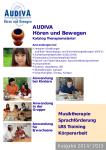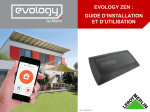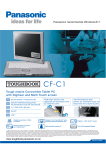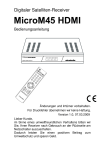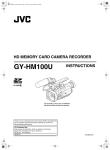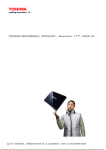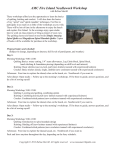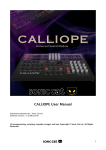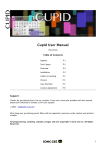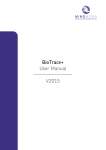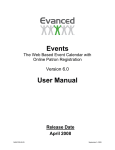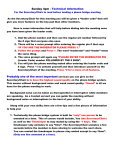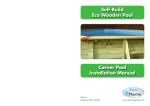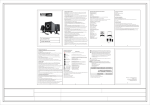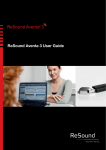Download as PDF
Transcript
Training plan Hearing Perception Training for parents - children Applications with the devices Hearing Perception Trainer HPT home / praxis / standard / spectrum Music therapy Phase A Speech therapy Reading training Spelling training Phase B for children and adults Contents Contents The training program: ............................................Page 3 Phase A - Music with the Hearing Perception Trainer HPT home/praxis/standard/spectrum. Listening to music in a familiar environment integrated into everyday life: ............................................................................Page 4 Activities while listening: ......................................................Page 5 Training chart:.....................................................................Page 6 The music phase A is a sensoric stimulating and emotional balancing phase. Reinforcement through the bone conductor: ..........................Page 22 Phase B - Language, speech, reading and writing with the Hearing Perception Trainer HPT home/praxis/standard/spectrum Audio books and training folders: Listen to tales on CD: ..........................................................Page 8 Listen to tales on CD + look at the book: ................................Page 8 Repeat words, sentences and tales: .......................................Page 9 Spelling/dictation exercises: ..............................................Page 10 Solve tasks: ......................................................................Page 10 Reading training:...............................................................Page 11 Let’s get started: Short instruction for the settings of the HPT devices: ...............Page 16 Note the training times in the charts for phase A starting Page 6 and for phase A+B starting Page 19. This documentation you can give to your therapist or doctor. They can help for a cost absorption by the health insurance. Hints: Quality control / efficiency review phase A: ........................Page 13 Quality control / efficiency review phase B: ........................Page 14 General Remarks: .............................................................Page 15 Order sheet for training material: .......................................Page 23 2 Tel.: +49 (0) 76 26-97 79-0 • Fax: +49 (0) 76 26-97 79-11 • Email: [email protected] • Website: www.audiva.de In the following chart you can see the different levels of intensity (= level 1 to 6), which are to be increased each week at the HPT home/praxis/standard/spectrum. During the first weeks the hearing program consists of a music therapy and - if necessary - is completed by a speech/reading training: Preschoolers and children until 2nd grade1 Level 1 Level 2 Level 3 Level 4 Level 5 School children from 1st grade and adults1 Level 6 Level 1 Week 1 Week 1 Week 2 Week 2 Week 3 Week 3 Week 4 Week 4 Week 5 Week 6 Week 7 Week 8 In the music training, level 6 does not necessarily have to be reached. If your child shows by his behavior that it is too much for him, please go back one level. Week 5 Week 6 Level 3 Level 4 Level 5 Level 6 In the music training, level 6 does not necessarily have to be reached. If your child shows by his behavior that it is too much for him, please go back one level. Week 7 Week 8 Week 9 Week 9 Week 10 Week 10 Week 11 Week 11 Week 12 Week 12 = music therapy (phase A) Level 2 The training program The training program = speech/reading training (phase B) Sensitive school children (mostly up to 2nd grade) should start with level 1 (left chart), like preschoolers. Especially in case of acoustic sensibilities (hyperacusis) it is recommended to start with level 1, irrespective of the age. For the entire training period: Duration of the training: 30-60 minutes. Listening to music either 3x a day for 10 minuts each oder twice a day for 20-30 minutes. Due to the stronger stimulus: the longer the better (max. 60 min.). It is highly recommended to install fixed hearing times (e.g. morning/afternoon/evening) in order to integrate the training into the daily routine (like brushing the teeth). For this, parental oversight is required, especially during the first days of the training. After this time, children often listen to the music (phase A) on their own. If the child refuses to do the training we recommend not to create a stressful situation. Better try to implement the training playfully and do activities that he likes, e.g. play cards, do handicrafts etc. 1. For adults there is a separate training plan available! See our website www.audiva.de and select Users > Adults in the menu. Tel.: +49 (0) 76 26-97 79-0 • Fax: +49 (0) 76 26-97 79-11 • Email: [email protected] • Website: www.audiva.de 3 Phase A (music): activation of the hearing Phase A (music): activation of the hearing Concept Starting from week 1: 3x a day for 10 minutes or twice a day for 20-30 minutes ... up to 60 minutes a day. Simply listen to the music with headphones via the HPT. Meanwhile relax or play. No effort, no stress, no „must“ ... the activation of the hearing has the best effect if no conditions are made. Just take care that the child does the training. Encourage him to play with his favorite toys or play with him! While listening to music it is recommended to: • • • • • • relax read do creative activities (handicrafts, painting...) have breakfast or other meals play parent-child / child-child parlor games (the headphones are sound permeable!). Caution: please choose a quiet environment! Switch off TV and radio. All calm and creative activities are allowed, TV, Gameboy, Playstation, PC etc. are not recommended. Exception: Children with a Playstation/computer addiction. In this case it is allowed to play while listening to the music. Ask if the child improved with the music in his game. Praise improvements! In the morning (very effective to start the day): In bed, during breakfast or after that - the 10 minutes in the morning should not be passed on! This stimulus is very effective for the upcoming strain in school or kindergarten: Wake your child up, switch on the device, put him the headphones on, start the CD player and let him start his day with Mozart. We recommend the CDs 1, 2, 4 und 5 from the set AMC S5 for the mornings. Switch on random mode on the CD player in order to create some variety in the playlist. In the afternoon (as a compensation after school/kindergarten): After school/kindergarten as a recreation of the stress during the morning. Alternatively also during lunch or before/during doing homework: There are children who can’t concentrate on their homework while listening to music. On the other hand, some children are able to do their homework faster and are more concentrated with music (no daydreaming, lingering, standing up). Just try how your child reacts! Always keep in mind that no concentration on the music is necessary. If your child in the beginning of the music therapy doesn’t tolerate listening to music while doing his homework, let him listen to the music right before doing his homework. Try after some weeks if now both together is possible. Reduce the music volume at the HPT device if your child reacts overwhelmed. Always act affectionally and react understanding, never put pressure on the child. In the evenings (to fall asleep relaxed and sleep through the night): After dinner or to fall asleep in bed. To fall asleep use CD 3 or CD 6 from our sets (AMC S5 or AMC S7). These CDs offer calm music. (CD 6+7 are part of the set AMC S7. If you own the set AMC S5, you can order further CDs separately for 8,90 EUR each.) 4 Tel.: +49 (0) 76 26-97 79-0 • Fax: +49 (0) 76 26-97 79-11 • Email: [email protected] • Website: www.audiva.de Ideas for activites while listening to the music. These ideas can be extended as you like. It is important • that the children are having fun, • that those who don’t superficially like the music draw their attention to an activity they like, • that the activities don’t make loud noises, • that no PC/game console is used (exceptions: see prior page, in the lower right corner of the box), • that headphones are carried. Activitiy Play Free painint Task Material build and play with building bricks, Lego, etc. existing material on a topic or completely free paper, colored pencils, sharpener Handicraft work ideas out of craft books craft book and additional material Color paintings color templates, add things template, colored pencils, sharpener and do additional activities, if applicable Color mandalas Phase A (music): Activity Phase A (music): Activity combine activities: count the number of objects (depending on the picture) do handicrafts: cut out templates, stick onto A3 sized paper and paint the environment like stable, pond, people etc. A3 sized papers, scissors, glue Color from inside to outside. Nach Wunsch auch umgekehrt, template, colored pencils, jedoch sollte eine Symbolgruppe fertig angemalt werden, sharpener, maybe scisbevor mit der nächsten begonnen wird. sors, colorful paper, glue Evtl. ausschneiden und auf ein buntes Blatt kleben. for templates see: www.free-mandala.com also try letter mandalas Labyrinth find the right way from "S" to "F", labyrinth on A4 sized (color the path) paper, 1 colored pencil, sharpener S for templates see: www.OneBillionMazes. com F Puzzle Number 35,023,491 Homework Copyright © 2005 OneBillionMazes.com While doing homework the child listens to the music via headphones. Sometimes this is only possible after a few weeks, once the child has an extended processing capacity. In this way the brain learns to process several activities at a time. A conscious one (homework) and an unconscious one (music). Thus the right hemisphere is engaged in processing the music while the left hemisphere „does the homework“. Also see page 4 „In the afternoon“. Tel.: +49 (0) 76 26-97 79-0 • Fax: +49 (0) 76 26-97 79-11 • Email: [email protected] • Website: www.audiva.de 5 Phase A+B (with speech & reading: Page 8) Chart: week 1-6 Phase A Phase A: fill in the boxes „morning“, „afternoon“, „evening“ with the listening time in minutes Week 1 Date Week 6 Week 5 Week 4 Week 3 Week 2 Chart: week 1-6 Phase A Phase A Music Morning Afternoon Evening Phase A Music level: Beginning phase till 7 yrs from 8 yrs 1 1 1 1 1 1 1 2 2 2 2 2 2 2 3 3 3 3 3 3 3 4 4 4 4 4 4 4 5 5 5 5 5 5 5 6 6 6 6 6 6 6 4 4 4 4 4 4 4 5 5 5 5 5 5 5 6 6 6 6 6 6 6 6 6 6 6 6 6 6 6 6 6 6 6 6 6 6 6 6 6 6 6 6 Phase A: Choose a different music CD each week. • Repeat favorite CDs. In general: if the stimulus is too much, adjust to a lower level and reduce the volume. 6 Tel.: +49 (0) 76 26-97 79-0 • Fax: +49 (0) 76 26-97 79-11 • Email: [email protected] • Website: www.audiva.de Remarks Phase A+B (with speech & reading: Page 8) Tabelle: 7.-12. Woche Phase A: fill in the boxes „morning“, „afternoon“, „evening“ with the listening time in minutes Week 12 Week 11 Week 10 Week 9 Week 8 Week 7 Date Morning Afternoon Evening Phase A Music level: Intensive phase depending on age 6 6 6 6 6 6 6 6 6 6 6 6 6 6 6 6 6 6 6 6 6 6 6 6 6 6 6 6 6 6 6 6 6 6 6 6 6 6 6 6 6 6 Remarks 6 6 6 6 6 6 6 6 6 6 6 6 6 6 6 6 6 6 6 6 6 6 6 6 6 6 6 6 6 6 6 6 6 6 6 6 6 6 6 6 6 6 Tabelle: 7.-12. Woche Phase A Musik Choose a different music CD each week. • Repeat favorite CDs. In general: If the stimulus is too much, adjust to a lower level and reduce the volume. Level 6 does not have to be reached, if the child shows by his behavior that it is too much for him. Tel.: +49 (0) 76 26-97 79-0 • Fax: +49 (0) 76 26-97 79-11 • Email: [email protected] • Website: www.audiva.de 7 Phase B: Speech and language exercises Phase B: Speech and language exercises Concept: For a few weeks the child only listened to music (phase A) whereby the sounds stimulated the brain. Now, if required, starting from week 7 additional speech exercises with audio books, exercise sheets and microphone are conducted. At least once a day for minimum 10 minutes. Conduct right after listening to the music. These exercises should be concucted in case of the following issues. Your child: • has a retarded language development. • doesn’t understand or misunderstands words and sentences. • has an unclear pronunciation. • can’t remember what he heard. • forgets quickly what he learned. The latter two points are already improved in phase A. Therefore it is often enough to conduct phase A. If retentiveness and memory don’t improve, go on here: The following exercises are to be conducted with audio books. For this the AUDIVA scorings which are read especially slowly and clearly are recommended. For these exercises you need a CD player, microphone, the HPT and 1-2 headphones (see the symbols in the boxes below). Stories with pictures are read to children who can’t read yet. The reader asks questions and gives clues. The child repeats, recounts, answers questions into the microphone and thereby is able to hear his own voice via the headphones. It is allowed to use the images of the audio books as a hint. General structure: 1: Listen to the CD of the audio book via the HPT: CD + HPT + For children and adults of all ages. 1: Listen to the CD of the audio book with headphones via the HPT at level 3 or 4. This is a good preparation for the next steps with the same book. Suitable for all ages. Repetitions are advisable, therefore listen to the same CD repeatedly several times. Always conduct exercise 1 before exercise 2. 2: Listen to the CD of the audio book via the HPT and look at the book: CD + + HPT + For children from 3-4 years and adults. Like exercise 1, now with pictures and the typeface. Small children look at the pictures or paint into the book. Looking at pictures while listening to the tale helps to capture the context. Children from 5 years get to know the characters (preparation for school) and school children playfully gain access to the writing. Repetitions are advisable, therefore listen to the same CD repeatedly several times and in doing so look at the book. 8 Tel.: +49 (0) 76 26-97 79-0 • Fax: +49 (0) 76 26-97 79-11 • Email: [email protected] • Website: www.audiva.de CD + + HPT + + For children from 3-4 years and adults. Exercise for child and parent: both wear headphones and the parent operates the CD player. After one sentence or half sentence press the pause button and the child repeats into the microphone. Then play the next sentence. Dear parents: Please practice the operation of the CD player and microphone before working with your child. In this exercise the child practices the auditive retentiveness and the attentiveness while listening together with speech (articulation). The child perceives himsels and learns to improve himself. Praise your child for small improvements already. This is a great exercise for children at preschool age with language retardation/speech development disorder. Phase B: Speech and language exercises 3: Listen to the CD of the audio book via the HPT and repeat into the microphone: Hint: If you have some more time: Conduct exercise 2 and 3 consecutively. Let the child recount the tale in his own words and ask him questions. 3a: Read out exercise folder via the HPT (parent), listen with headphones and let the child repeat into the microphone/solve a task: Folder „Holta di Polta“ or „Alles Banane“ + + HPT + + For children from 5 years and adults. The exercises from the folder always consist of an A4 sized exercise sheet. On top it is indicated what to do, then follows an example and eventually come the actual exercises. The parent holds the microphone, reads out the exercise and then holds the microphone for the child (a bit underneath the chin works best). Just like in an interview the child says the answer of the respective task. Praise your child after a correct answer and also for the endurance. These exercises are also suitable for adults, e.g. in an aphasia therapy. Tel.: +49 (0) 76 26-97 79-0 • Fax: +49 (0) 76 26-97 79-11 • Email: [email protected] • Website: www.audiva.de 9 Phase B: Reading and spelling training Phase B: Reading and spelling training Concept: For a few weeks the child only listened to music (phase A) whereby the sounds stimulated the brain. Now, if required, starting from week 7 additional speech exercises with audio books, exercise sheets and microphone are conducted. At least once a day for minimum 10 minutes. Conduct right after listening to the music. Starting from the reading age, if your child: • does many mistakes in dictations. • confuses letters and endings. • reads slowly and haltingly. • doesn’t like reading at all. • doesn’t want to read out loud. • has problems with a foreign language. • can’t remember vocabulary. Dictation exercise: 3b: Listen to the CD of the audio book via the HPT, then repeat slowly into the microphone and write down: CD + + HPT + + + For children from 1st grade and adults. Exercise for child and parent: both wear both wear headphones and the parent operates the CD player. After one sentence or half sentence press the pause button, the child repeats into the microphone and at the same time writes down the sentence. Then play the next sentence. Dear parents: Please practice the operation of the CD player and microphone before working with your child. This is an exercise in order to practice the auditive retentiveness and the attentiveness together with speaking (articulation) and writing, as well as to combine hearing and writing. The child perceives himsels and learns to improve himself. Praise your child for small improvements already. 4a: Listen to the CD of the audio book via the HPT and speak the solution of a task into the microphone: CD + + HPT + 4b: Read the book quietly via the HPT and speak the solution of a task into the microphone: Book + + HPT + For children from 1st grade and adults. Hearing and reading exercises for an attentive reading (quiet or aloud) in a therapy for reading and writing disorder (dyslexia) of schoolchildren. 10 Tel.: +49 (0) 76 26-97 79-0 • Fax: +49 (0) 76 26-97 79-11 • Email: [email protected] • Website: www.audiva.de 5: Read a book aloud into the microphone via the HPT: Book + + HPT + For children from 1st or 2nd grade and adults. Reading exercise for fluent reading. Reading akoud into the microphone promotes self-perception and self-control. Later, the contents can also be tested orally (go on with exercise 3). Use books according to age and interests: Read a book page or a chapter aloud into the microphone. Since this exercise works without CD you can use any book. The child will be most motivated when working with books which are interesting for him. Hint: At the same time, play a music CD of our Set in the background via the HPT (lower the volume of the CD so that the microphone voice is in the foreground and the music in the background). Often, this leads to a better voice and fluent reading. Phase B: Reading and spelling training Solve the tasks while listening (4a) or while reading the book quietly (4b). The respective solutions are spoken aloud into the microphone. Have the child write down the words additionally in order to train the spelling. Caution: Always give enough time using the pause button at the CD player. Invent special exercises and practice them with the book: i.e. find beginnings and endings of words, individual sounds/sound groups or entire words which contain specific sounds (i.e. "en", "an"). Example 1: If the child confuses "d" and "t", make him read out loud from the book only those words that contain one of these sounds (4b). Example 2: Like before, but with a CD instead of a book: the child listens attentively and repeats only the particular words into the microphone (4a). 6: Listen to a CD via the HPT + read a book aloud into the microphone via the HPT: CD + Book + nd For children from 2 or 3 + HPT + rd grade and adults. Reading exercise for fluent reading and being distracted less easily - demanding exercise: while listening to the CD, read the book aloud into the microphone. The child hears the voice of the speaker and his own voice, both with the headphones via the HPT. Conduct this exercise only with advanced children. Otherwise exercise 5 is enough. A daily situation in the classroom: One pupil reads aloud and some others talk and whisper. Exercise 6 trains to not mind the conversations of others and read the text aloud „stubbornly“ and concentratedly. This first takes place at home in a save place and therefore helps to reduce the fear and nervousness the child has in school. Your child becomes more secure and approaches this task self-confidently. Hint: In the beginning adjust the volume of the CD a bit lower, thereby the distraction is less. What else you can use: • • • • Audio books from retail shops or the library: keep in mind to use readings only with a clear voice. There should be no sounds or music in the background. Normal audio books like Harry Potter have a faster speaking rate of approx. 140 words/minute and are articulated not very well. Therefore we recommend our AUDIVA audio books since we paid attention to a slow and distinct pronunciation. However, if your child already made progress in reading it is good to work with faster and less distinctly spoken texts in order to become even faster and more secure. To use tales, stories or current school material without CD: here the parent reads aloud. Always mind your slow and distinct pronunciation. Only use texts which are interesting for the child. Only use school material if it is interesting, otherwise choose those texts which the child prefers. This is crucial for his motivation. For adults there are poems and ballads as audio books. Tel.: +49 (0) 76 26-97 79-0 • Fax: +49 (0) 76 26-97 79-11 • Email: [email protected] • Website: www.audiva.de 11 The exercise elements of phase B 12 The exercise elements of phase B Learning to hear oneself speak An important element in phase B is speaking or reading into the microphone. Children with disorders in hearing or hearing processing have difficulties to perceive themselves and others and they have trouble to use the speech in their environment as an example. As a result they get speech and/or language therapy which doesn’t bring the desired success if the hearing perception is impaired, as well (APD). Influence of earlier years: This also applies for children who had a hearing impairment in earlier years, i.e. because of many middle ear inflammations, tympnic tube or colds over longer periods. Even though this situation is now better, the brain lacks hearing experience from this time. With the hearing training by AUDIVA the necessary hearing experience can be caught up on within a short period of time. Therefore we use the technique of the HPT. Problems only in school: Sometimes the problems that were treated with speech therapy at a preschool age come back in school. Again the child confuses sounds when writing. The aim of the AUDIVA hearing training is a secure integration of the speech sounds in combination with spelling. Compensation with the eyes? A common recommendation for the child is to work a lot with the eyes. This, however, is a compensatory strategy and a recommendation based on ignorance, since many people still believe that the hearing system cannot be trained. Our research and experience prove the exact opposite. Even more specific speechtraining: By speaking into the microphone the self- and external perceptionis improved since frequencies relevant for speech are enhanced. Thereby the brain can better perceive the differences between speech sounds. Moreover, motoric articulation patterns can be learned better and permanently because of the improved hearing control. In the HPT home and HPT praxis there are fitration programs included that emphasize individual sound groups (see picture on the right). Proceed like explained in the user manual of your HPT home / HPT praxis. The exercises 3, 3a and 4a explained above can be conducted with these settings. Otherwise simply choose level 3 or 4. Tandem reading training: A new method for the training of reading aloud is the tandem or partner reading method. Form a couple: a good reader and a less good reader. At home the parent or a better reading sibling functions as the good reader (tutor) and sits closely next to the less good reader. He chooses an interesting text which he lays in front of both readers. At a sign both start reading simultaneously and the tutor points with his fingers underneath the words both are reading. The tutor watches out for reading mistakes and repeats the sentence from the beginning. When the less good reader becomes more and more secure the tutor stops reading and only continues pointing with the finger. If a mistake occurs the tutor corrects it and both go on reading aloud. At the end of a text there is a conversation about the content (did the less good reader remember the content?). This training can be conducted like exercise 5 by positioning the microphone in the middle of both readers. Tel.: +49 (0) 76 26-97 79-0 • Fax: +49 (0) 76 26-97 79-11 • Email: [email protected] • Website: www.audiva.de The hearing training ends after 12 weeks according to plan, but may be prolonged: Continue or stop the music therapy (phase A)? Did you observe changes in behavior, like: • improved attentiveness? • extended concentration periods? • better bearing of loud sounds? • better retention of syllables, sentences and stories? • better bearing and blinding out of ambient noises? • did the dreaminess or restlessness go back? • is the mood more balanced, can you observe more cheerfulness? • did the sleeping rhythm improve? These changes are obtained by the music therapy with the HPT and can be observed sometimes already after the first weeks, but often only towards the end of the 12 weeks. In general the music therapy can be prolonged if the children like doing it or if the positive effects are desirable further on. If you end the music therapy here, observe if the success is stable or if there are regressions. If you observe regressions, continue with the trianing in order to stabilize the success. After a few weeks pause start a new therapy block of 12 weeks. If you observe a stable success, compare the progress again after half a year. If they are stable the progress is integrated succesfully and the training is finished. If not, do another therapy block of 12 weeks! If you don’t observe any success, it can have the following reasons: • the training was done too seldomly • the selected music was not suitable • only one or two CDs were used Remedial action: order the music CD set with 5 different CDs (AMC S5, please see last page) Your child is bored during the music therapy. Remedial action: Offer fun activities while listening to the music. See Page 5 Your child complains about headache or other symptoms Remedial action: reduce the headphones volume at the HPT. You can also go back one level. It is not always necessary to reach level 6! After 12 weeks of music therapy (phase A): Efficiency review After 12 weeks of music therapy (phase A): Efficiency review Rejection of the training - possible reasons: the child feels that he has to do therapy. Remedial action: 1. avoid statements like „you need this, because...“, since this causes pressure. Impart a positive, joyful attitude towards the hearing training. 2. Parent and child both can listen to the music. Meanwhile play a game and don’t mind the music. Just engage joyfully in playing the game. 3. Reduce the volume in order to avoid having the music in the foreground. 4. Offer an activity to do in the meanwhile: see Page 5. Tel.: +49 (0) 76 26-97 79-0 • Fax: +49 (0) 76 26-97 79-11 • Email: [email protected] • Website: www.audiva.de 13 After 12 weeks of music and speech/language therapy (phase 14 After 12 weeks of music and speech/language therapy (phase A+B): Efficiency review This page is applicable for you if you also conducted phase B. When phase B was conducted: Did you observe any progress in speaking, reading and spelling? • did the speaking improve? • are there less mistakes in dictations? • is the spelling better? • did the type face improve? • did the reading become more fluent? • does the child like reading more than before? These achievements sometimes already occur during the music therapy (phase A). Mostly, however, a dyslexia training is conducted with the HPT device and a microphone and headphones (phase B). By observing your child, consulting teachers and evaluating dictations you as a parent can see if there were any improvements here. In the first instance and irrespective of test scores - you should be able to notice the changes in everyday life. The test scores only translate the progress into numbers. If you end the speech therapy or the reading and spelling training now, observe if the progress lasts or if there are regressions. If you observe regressions, the training should be resumed in order to stabilize improvements. After a few weeks of pause start with a new therapy block of 12 weeks. If you observe a stable success, compare the progress again after half a year. If they are stable the progress is integrated succesfully and the training is finished. If not, do another therapy block of 12 weeks! If you repeat a therapy block it is recommended to renew/adapt/improve the content in order to offer some variety and new motivation. For this we or your therapist are at your service. If you don’t observe any success, it can have the following reasons: • The problems of the child are very distinct, so that he needs a longer activation with the music therapy (phase A) until he is ready for phase B. • The wrong training contents were used. • The usage of microphone/headphones is unclear. Remedial action: Call us (telephone number: see below) or your therapist for an individual consultation regarding the suitable training contents and the execution of the training. Tel.: +49 (0) 76 26-97 79-0 • Fax: +49 (0) 76 26-97 79-11 • Email: [email protected] • Website: www.audiva.de For the entire training phase: If the training is interrupted for longer than 4 weeks, lower the level about one step. Hints: • Document the improvements in the tables provided. This can help for a retrospective cost absorption of the health insurance. • Show the documented success also to your doctor. He can issue a prescription which also facilitates a cost absorption. The training at home is not possible? • Offer the hearing perception training at the therapist’s office (group training with headphones distributors): at least 2x a week, 45 min each session • Offer the hearing perception training for children as a learning strategy in private coaching. Inform the private tutor about the posibilities: Learning is easier with the stimulation through music and learning contents offered via the microphone/headphones are elucidated by the training device and thereby the memory effect is enhanced. • Daily hearing perception training in remedial teaching, in special needs schools, kindergartens, daycare centers, etc. General remark: General remark: We also offer individual consulting. Call us (telephone no. please see below) or ask your therapist. Prolonging the training: • If you decide to purchase your rental HPT device we allow the entire rental charge for the purchase. The shipping and processing fee cannot be reimbursed. • You can always prolong the rental period. Just give us a call! • You can send the device back to us and rent it again after a certain observation period. Jut give us a call! • Contact us in order to find the ideal solution for you. Further use of the HPT: A HPT device can be used by the entire family: siblings can utilize the hearing training preemptively, parents can relax and charge their batteries with it for the everyday working life. Adults and seniors can keep their hearing fit and active and teenagers can prepare themselves for exams or learn a foreign language more easily with the HPT and a microphone. Tel.: +49 (0) 76 26-97 79-0 • Fax: +49 (0) 76 26-97 79-11 • Email: [email protected] • Website: www.audiva.de 15 Brief instruction for the settings of the training devices Brief instruction for the settings of the training devices Please check user manual for the connection of the devices and a detailed operation. HPT home: Having switched on choose „Sequencing“ (press the lowest + button). Then select a level between 1 and 6 (press uppermost +/- buttons several times) and start the training (again with the lowest + button). Hint 1: If you „mistyped“ press the left button underneath the display (back) and start from the beginning. Hint 2: depending on how much time you have, choose the full level (30 min.) or morning/afternoon/evening (10 min. each). Hint 3: In order to avoid rushing position the controller „volume microphone“ to „0“ when no micorophone is being used. HPT praxis: Having switched on press the buttom „time“ (underneath the display). Then select a level between 1 and 6 (press uppermost +/ - buttons several times) and start the training (again with the lowest + button). Hint 1: If you „mistyped“ press the button „time“ again and. Hint 2: depending on how much time you have, choose the full level (30 min.) or morning/afternoon/evening (10 min. each). Hint 3: In order to avoid rushing position the controller „volume microphone“ to „0“ when no micorophone is being used. HPT standard: Having switched on choose a level between 1 and 6 with the controller. The device doesn’t have a time limit for the hearing training. The volume is adjustable by the volume control at your CD player. In action the lamp „status“ switches slowly from red to green. Hint: In order to avoid rushing position the controller „volume microphone“ to „0“ when no micorophone is being used. HPT spectrum: Having switched on the device automatically starts with the title selected last. Select a level between 1 and 6 with the controller. The hearing training has a time limit which is adjustable by the sleeper timer (see user manual). In action the lamp „status“ switches slowly from red to green. In this model there is a built-in rechargeable battery and music. Just plug in the headphones and start with the hearing training. A bone conductor also is directly connectable. On the following pages you can find training charts for the training devices HPT home/praxis/standard/spectrum: Please record the daily training sessions. The charts function as an evidence for a regular training for the therapist, doctor or health insurance. 16 Tel.: +49 (0) 76 26-97 79-0 • Fax: +49 (0) 76 26-97 79-11 • Email: [email protected] • Website: www.audiva.de Phase A: fill in the boxes „morning“, „afternoon“, „evening“ with the listening time in minutes Week 6 Week 5 Week 4 Week 3 Week 2 Week 1 Date Morning Afternoon Evening Phase A Phase B level level music speech 1 1 1 1 1 1 1 2 2 2 2 2 2 2 3 3 3 3 3 3 3 4 4 4 4 4 4 4 5 5 5 5 5 5 5 6 6 6 6 6 6 6 Remarks - Chart: Week 1-6, beginning phase for children till 7 years Chart: Week 1-6, beginning phase for children till 7 years Phase A: Choose a different music CD each week. • Repeat favorite CDs. In general: if the stimulus is too much, adjust to a lower level and reduce the volume. Tel.: +49 (0) 76 26-97 79-0 • Fax: +49 (0) 76 26-97 79-11 • Email: [email protected] • Website: www.audiva.de 17 Phase A: fill in the boxes „morning“, „afternoon“, „evening“ with the listening time in minutes If phase B is required: conduct speech exercises once a day for 10 min. right after listening to the music Week 9 Week 8 Week 7 Date Week 12 Week 11 Week 10 Chart: Week 7-12, intensive phase for children till 7 years Chart: Week 7-12, intensive phase for children till 7 years Morning Afternoon Evening Phase A Phase B level level music speech 6 6 6 6 6 6 6 6 6 6 6 6 6 6 6 6 6 6 6 6 6 6 6 6 6 6 6 6 6 6 6 6 6 6 6 6 6 6 6 6 6 6 Phase A: Choose a different music CD each week. • Repeat favorite CDs. Remarks 3 3 3 3 3 3 3 3 3 3 3 3 3 3 3 3 3 3 3 3 3 3 3 3 3 3 3 3 3 3 3 3 3 3 3 3 3 3 3 3 3 3 Phase B: When speaking into the microphone, you can also reduce to level 2. In general: if the stimulus is too much, adjust to a lower level and reduce the volume. 18 Tel.: +49 (0) 76 26-97 79-0 • Fax: +49 (0) 76 26-97 79-11 • Email: [email protected] • Website: www.audiva.de Phase A: fill in the boxes „morning“, „afternoon“, „evening“ with the listening time in minutes Week 6 Week 5 Week 4 Week 3 Week 2 Week 1 Date Morning Afternoon Evening Level Level music speech 4 4 4 4 4 4 4 5 5 5 5 5 5 5 6 6 6 6 6 6 6 6 6 6 6 6 6 6 6 6 6 6 6 6 6 6 6 6 6 6 6 6 Phase A: Choose a different music CD each week. • Repeat favorite CDs. Remarks 3 3 3 3 3 3 3 3 3 3 3 3 3 3 3 3 3 3 3 3 3 Chart: Week 1-6, beginning phase for children from 8 years Chart: Week 1-6, beginning phase for children from 8 years Phase B: When speaking into the microphone, you can also reduce to level 2. In general: if the stimulus is too much, adjust to a lower level and reduce the volume. Tel.: +49 (0) 76 26-97 79-0 • Fax: +49 (0) 76 26-97 79-11 • Email: [email protected] • Website: www.audiva.de 19 Phase A: fill in the boxes „morning“, „afternoon“, „evening“ with the listening time in minutes If phase B is required: conduct speech exercises once a day for 10 min. right after listening to the music Week 10 Week 9 Week 8 Week 7 Date Week 12 Week 11 Chart: Week 7-12, intensive phase for children from 8 years Chart: Week 7-12, intensive phase for children from 8 years Morning Afternoon Evening Level music Level speech 6 6 6 6 6 6 6 6 6 6 6 6 6 6 6 6 6 6 6 6 6 6 6 6 6 6 6 6 6 6 6 6 6 6 6 6 6 6 6 6 6 6 3 3 3 3 3 3 3 3 3 3 3 3 3 3 3 3 3 3 3 3 3 3 3 3 3 3 3 3 3 3 3 3 3 3 3 3 3 3 3 3 3 3 Phase A: Choose a different music CD each week. • Repeat favorite CDs. Remarks Phase B: When speaking into the microphone, you can also reduce to level 2. In general: if the stimulus is too much, adjust to a lower level and reduce the volume. 20 Tel.: +49 (0) 76 26-97 79-0 • Fax: +49 (0) 76 26-97 79-11 • Email: [email protected] • Website: www.audiva.de Phase A: fill in the boxes „morning“, „afternoon“, „evening“ with the listening time in minutes If phase B is required: conduct speech exercises once a day for 10 min. right after listening to the music Morning Afternoon Evening Phase A Phase B level level music speech Remarks Week ___ Week ___ Week ___ Week ___ Week ___ Week ___ Date Training chart: from week ___ to week ___ • HPT _________ Training chart: from week ___ to week ___ • HPT _________ Phase A: Choose a different music CD each week. • Repeat favorite CDs. In general: if the stimulus is too much, adjust to a lower level and reduce the volume. Tel.: +49 (0) 76 26-97 79-0 • Fax: +49 (0) 76 26-97 79-11 • Email: [email protected] • Website: www.audiva.de 21 Intensify the hearing training with the bone conductor: 22 Intensify the hearing training with the bone conductor: In phase A: The bone conductor is in direct contact with the skullcap due to the headband (see picture). The sound is transfered through the impact of the skin onto the skull. The bone transfers the sound directly into the inner ear and you can hear! At the same time sound resonances in the head are stimulated which also occur when speaking. The bone conductor is an important support for children with a heavy language retardation, heavy disorders of attention, autism, mental disability as well as acute hearing loss, tinnitus, deafness. We recommend for these treatments a combination of headphones and bone conductor (KHS 160A). This training method is also known from the Tomatis therapy and serves as an additional activation in phase A when listening to the music. Headphones with bone conductor combined KHS 160 A Bone conductor and headphones are ready-mounted with a joint cable link. In the middle of the headband of a QP160 headphone a bone conductor is mounted. When carried the sound transmission onto the skull is guaranteed. The bone conductor can be removed from the headband and used manually. Cable 1,2m and 5m extension with suitable labeled plug connections. Ord. no.: KHS 160 A with 2x 3,5mm jack plug and 2x adapter for 6,3mm jack plug EUR 229,00 Amplifier for bone conductor EHT 26 This amplifier for the bone conductor is necessary with the HPT home and standard (already integrated in the HPT praxis and spectrum). ❥ the sound level ratio between bone and air conduction is adjustable steplessly ❥ two stereo channels for 1 or 2 bone conductors and 2 stereo headphones at the same time ❥ with mono-stereo-switch and left-right balance regulation each Control desk with labeled front and back side as well as connection plugs on the back. Dimensiosn: width x height x depth: 161 x 40/60 x 97 mm Ord.no.: EHT 26 Power supply unit, connection cable, user manual Tel.: +49 (0) 76 26-97 79-0 • Fax: +49 (0) 76 26-97 79-11 • Email: [email protected] • Website: www.audiva.de EUR 149,00 Via fax to AUDIVA (for Austria - see below): AUDIVA, Behlenstr. 3, D - 79400 Kandern 0049 (0) - 7626 - 9779-11 Or order by phone: 0049 (0) - 7626 - 9779-0 Order of training material and accessories Pieces Article Order no. Price per unit € Total price € For phase A (music therapy) HPT home AMC S5 AMC S7 CDP 109 QP 160 39,00 55,00 49,00 49,00 Microphone for HPT home/praxis/spectrum EM 103 30,00 Microphone table stand MS 1 Hearing Perception Trainer home Music CD Set, 5 CDs Music CD Set, 7 CDs Portable CD player Headphones For phase B: 6,90 Others: Shipping fees: 5 € within Germany, 20 € within EU, 55 € overseas Hereby I order the listed articles and choose the following payment method: Shipping fees: Total price: ❑ Prepayment (decuction of 3% discount, you will receive an advance invoice) ❑ PayPal: to the address [email protected] Billing and shipping address: Order of training material and accessories Send to: Different shipping address: Company/Title: Name: Street address: Zip-Code/City: Country: Tel.: eMail (optional): Delivery date: Date: ❑ immediate ❑ at the: ........................................... Signature: Notes: Tel.: +49 (0) 76 26-97 79-0 • Fax: +49 (0) 76 26-97 79-11 • Email: [email protected] • Website: www.audiva.de 23
























